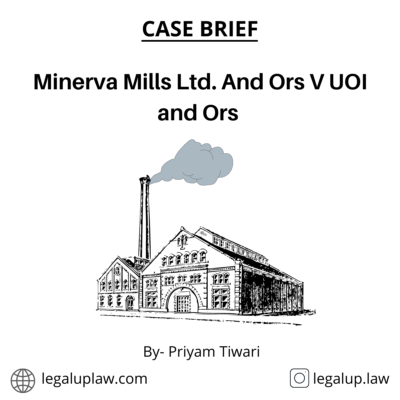LegalUp’s Snippy:– The Parliament is recognized as the legislature which not only makes laws but also has the power to amend the laws of the constitution for the welfare of the citizens. After the Independence of the country, the states for the welfare of the citizens started making changes in the Social and economic law, such changes were also done in Kerala, due to which the people realized that their fundamental right is being violated. So they decided to file a suit regarding the same.
Table of Contents
Introduction
India with its population is a huge country and because of which it becomes very difficult to provide welfare to all. But the government on regular basis makes laws to achieve such motive, after the independence of the country, the social and economic conditions of the citizens were not very good, due to which the states decided to make laws that can counter these problems.
But this was not the only reason, after the Indian Constitution came into force, the provision of the right to equality come into being which encourages the state government to change their existing laws.
Kerala state government was one such state which made certain changes to maintain their social and economical aspects to meet the right of equality. They made changes in the Zamindari System, Land Ownership, and Tenancy Laws to meet goals and a new Land Reform Act, 1963 was passed by the Kerala state government.
The new land reform system puts restrictions on the amount of land owned by a person, basically, it restricts the right of property of a person. By using this act, the government order to acquire the land of Edneer Mutt of Kasaragod district.
Issues
- Whether the Parliament has the authority/ power to amend the provision of the India Constitution or not, specially the fundamental rights of the citizens.
- If the Parliament has the power to amend the laws then upto what extent they can amend the provision.
The land reform and Constitutional amendments were challenged before the court.
Facts of the case

Kesavananda Bharati was the head of the Edneer mutt group, and she challenged the Land Reform in the Supreme Court in March 1970, because the income of the mutt land started decreasing day by day and various new financial crises started taking place.
Note- Kesavananda Bharati only challenged the law and filed a suit for it but the same was represented by the Nana Bhai Phalkivala on her behalf.
She pleaded in her suit that the Land Reform violates our fundamental rights such as ART-14, Art-19(f), ART-25, and ART-26. She also said that a person has a fundamental right to freely hold and manage his/her property according to their choices, and these rights should be protected.
This was the time when Bank Nationalization case, 1970, Madhav Rao Scindia case 1971, and Golaknath case 1967 were going under which both the higher authorities Parliament and Supreme Court were struggling power issues among each other.
The Parliament was of the opinion that under Article- 368 of the constitution, it gives unlimited powers to the Parliament to amend the constitution and to any extent, but the Supreme Court totally disagree with the statement made by the Parliament.
- In the case of Golaknath vs State of Punjab, 1967
It was held by the Supreme Court that it imposed immense restriction on the authorities of the Parliament to amend the provisions of the constitution.
In order to clear the restriction made by the Supreme Court on Parliament, they made 24th, 25th, and 29th amendment act.
24th amendment– Power to amend the Constitution by Parliament to any extent.
25th amendment– The right to property can be curtailed, and government can acquire the private property for the welfare of the society, and also the compensation for the same property will be decided by the Parliament and not by the Courts
29th amendment– Land Reform act was put under the 9th schedule of the Constitution. The reason behind putting the Land Reform into the 9th schedule was that under the 9th schedule no one can question/ challenge/ review the provision in the Courts.
Petitioner’s Argument
- The petitioner was of the view that power provided under Article-368 of the constitution is not a absolute power whereas it is a limited or restrictive power provided to the constitution. Therfore the parliament cannot ammend any of the provisions provided in the constitution
- Secondly, the petitioner arugues that, the rights given in the constitution
is to protect the freedom of the citizen. like for.eg- Article- 19(f) which talks about the right to property of an individual. But the respondant in their 24th and 25th amendment act which was taken from Article-31 imposes restrictions on the fundamnetal rights of the citizens.
Respondant’s Argument

- The Respondent were of the view that Parliament has unlimited and absolute power to amend the constitution of the India, along with it they argue that acording to them every state wanted to improve their citizens standard of living by making changes in the social and economic laws, and for the same their should not be any restriction on the Parliament to amend the laws. Because it will directly limits the power of the Parliament to do welfare of the citizen.
- They also argued that the parliament has the power to put restriction on the fundamental rights of the citizen like, for eg- freedom of speech and expression, right to form association and freedom of religion.
Judgement
- The Supreme Court overruled the judgement of Golaknath vs State of Punjab.The court was of the opinion that parliament can ammend the fundamental rights of the citizens.
- The court also said that the 24th amemdment act is valid, and the Parliament has the power to amend any provision of the Indian Constitution, and they also added that the parliament has the absolute power to amend any provision of the constitution.
- But the court also added that even though the Parliament has the power to amend the provision of the consitution, they cannot interfere with the basic features/ essential features of the Consitution. The court name this concept as the Basic Structure Doctrine.
- The court said that the 25th and 26th amendment of the Constitution is also valid but if any law is put in the 9th schedule, then it can be reviewd by the courts, only if they violate the basic features of the Constitution, Parliament is given unlimited powers but it cannot interfere with the basic features of the constitution.
Note- The Basic features will differ from case to case.
Conclusion
Every government wants their citizens to live a satisfactory life, with all the amenities provided by them and for the same power is given to them, but they should not forget the fact that making laws should not infringe the fundamental rights of the citizens. In this case, Parliament has given the right to protect their citizen but also given certain limitations so that no authority could misuse its powers in the wrong direction.
Important facts of the case Kesavananda Bharati v. State of Kerala
- This case was one of the longest case in India, it’s proceeding was done for the duration of 68 days.
- 100 plus cases was cited in this case, and also compared around 70 plus constitution of the world in order to understand things whether they were right or wrong.
- Judgement is of 703 pages, and it is one of the important cases in the history of India.
- Largest bench was seated in this case to decide on the matter. 13 Judges bench.
5 The Judgement came with the majority of 7:6.






1 Comment